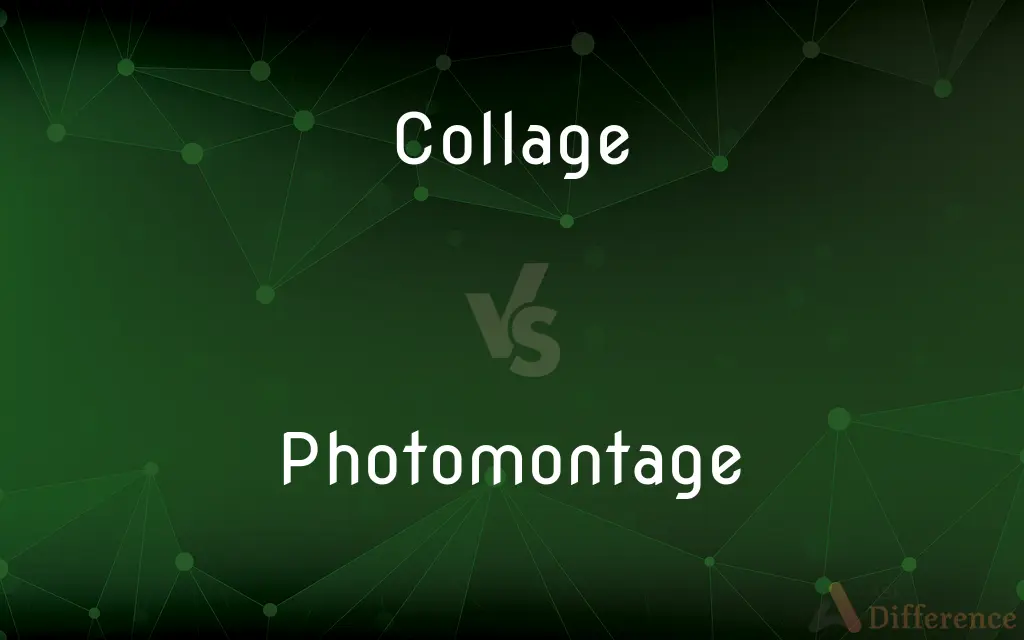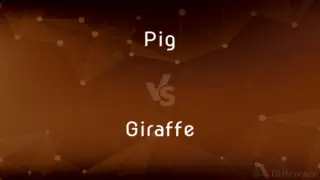Collage vs. Photomontage — What's the Difference?
By Maham Liaqat & Urooj Arif — Updated on March 11, 2024
Collage combines various materials like paper and fabric on a surface, whereas photomontage specifically assembles photographs to create a new image.

Difference Between Collage and Photomontage
Table of Contents
ADVERTISEMENT
Key Differences
Collage is an artistic technique that involves assembling different forms of materials, such as paper, fabric, and found objects, onto a surface to create a new piece of art. This method allows for a broad exploration of textures, colors, and compositions, blending diverse elements into a cohesive whole. Photomontage, on the other hand, is a specific type of collage focused on the use of photographs. Artists cut and rearrange pieces of photographs or photographic prints to produce a new, unified image, often to convey a message or explore complex themes.
The origins of collage can be traced back to early 20th-century art movements like Cubism and Dadaism, where artists like Pablo Picasso and Georges Braque began incorporating bits of newspapers and other ephemera into their paintings. This approach broke traditional boundaries and introduced a new way of seeing relationships between different elements. Photomontage emerged around the same time, with artists such as Hannah Höch and John Heartfield using the technique to comment on political and social issues, demonstrating the powerful potential of photography as a tool for artistic expression and critique.
Collage offers artists the freedom to include a wide range of materials, not limited to visual elements. Textual components, such as book pages or handwritten notes, and tactile materials like fabric or wood, can be incorporated, providing a rich sensory experience and depth. Photomontage, while primarily visual, emphasizes the manipulation of photographic images to alter perceptions of reality or create surreal or abstract compositions. The focus is on the photographic image's power to document, manipulate, and communicate.
The techniques used in creating collages and photomontages also differ. Collage artists might employ cutting, tearing, and layering of materials, combining painting or drawing to integrate diverse elements. Photomontage artists, however, work extensively with photographic images, cutting, rearranging, and often using digital editing tools to seamlessly blend images together, creating a new reality or visual narrative.
While both collage and photomontage are used to make statements or explore artistic concepts, the choice between them often depends on the message the artist wishes to convey and the materials they wish to use. Collage is versatile and can express a broader range of themes through its various materials and textures. Photomontage is particularly effective in manipulating and recontextualizing photographic imagery to explore perceptions of reality, memory, and identity.
ADVERTISEMENT
Comparison Chart
Definition
Art form combining various materials like paper and fabric on a surface.
Art form assembling photographs to create a new image.
Origin
Early 20th century, linked with Cubism and Dadaism.
Emerged alongside collage, with a focus on photographs.
Materials
Diverse, including paper, fabric, and found objects.
Primarily photographic images.
Techniques
Cutting, tearing, layering, may include painting or drawing.
Cutting, rearranging photographs, often involves digital editing.
Purpose
To explore textures, colors, and composition; can include tactile and textual elements.
To manipulate photographic images, focusing on altering perceptions of reality.
Compare with Definitions
Collage
Mixed Media.
The artist's collage included newspaper clippings, fabric scraps, and acrylic paint, showcasing a vibrant textural contrast.
Photomontage
Photographic Focus.
The photomontage combined historical and contemporary images to critique social change, creating a powerful visual statement.
Collage
Artistic Freedom.
Collages offer the freedom to experiment with different materials, creating unique, multi-dimensional artworks.
Photomontage
Political and Social Commentary.
Photomontages have been used effectively to convey political messages, manipulating familiar images to question or protest.
Collage
Historical Context.
Early collages challenged traditional art forms, incorporating everyday materials to reflect contemporary life.
Photomontage
Digital Techniques.
Modern photomontages often utilize digital tools, allowing for precise manipulation and blending of images.
Collage
Tactile Experience.
The tactile quality of a collage can evoke a more personal connection, inviting viewers to explore its physicality.
Photomontage
Reality and Perception.
Photomontages challenge our perceptions of reality, presenting altered images that blur the lines between truth and fabrication.
Collage
Visual and Textual Narrative.
By incorporating both visual and textual elements, collages can tell complex stories within a single frame.
Photomontage
Surrealism and Abstract Art.
Artists use photomontage to create surreal or abstract compositions, pushing the boundaries of conventional photography.
Collage
Collage (, from the French: coller, "to glue" or "to stick together";) is a technique of art creation, primarily used in the visual arts, but in music too, by which art results from an assemblage of different forms, thus creating a new whole. (Compare with pastiche, which is a "pasting" together.) A collage may sometimes include magazine and newspaper clippings, ribbons, paint, bits of colored or handmade papers, portions of other artwork or texts, photographs and other found objects, glued to a piece of paper or canvas.
Photomontage
Photomontage is the process and the result of making a composite photograph by cutting, gluing, rearranging and overlapping two or more photographs into a new image. Sometimes the resulting composite image is photographed so that the final image may appear as a seamless physical print.
Collage
A piece of art made by sticking various different materials such as photographs and pieces of paper or fabric on to a backing.
Photomontage
The technique of making a picture by assembling pieces of photographs, often in combination with other types of graphic material.
Collage
An artistic composition of materials and objects pasted over a surface, often with unifying lines and color.
Photomontage
The composite picture produced by this technique.
Collage
A work, such as a literary piece, composed of both borrowed and original material.
Photomontage
(photography) A composite image combining two or more photographs.
Collage
The art of creating such compositions.
Photomontage
(photography) The art of constructing such images.
Collage
An assemblage of diverse elements
A collage of conflicting memories.
Photomontage
A montage that uses photographic images
Collage
To paste (diverse materials) over a surface, thereby creating an artistic product.
Collage
To create such an artistic product.
Collage
A picture made by sticking other pictures onto a surface.
Collage
A composite object or collection (abstract or concrete) created by the assemblage of various media; especially for a work of art such as text, film, etc.
Richard Brautigan's novel So the Wind Won't Blow It All Away is a collage of memories.
Collage
(uncountable) The technique of producing a work of art of this kind.
Collage
(transitive) To make into a collage.
Collage the picture together.
Collage
Any picture made by sticking together pieces of paper or photographs, especially in unusual or surprising ways.
Collage
The technique of producing a work of art that is a collage{1}.
Collage
Any composite object, whether abstract or concrete, created by assembling components of varied types.
Collage
A film having scenes of different types or from different locations displayed in rapid succession without transitions.
Collage
A paste-up made by sticking together pieces of paper or photographs to form an artistic image;
He used his computer to make a collage of pictures superimposed on a map
Collage
Any collection of diverse things;
A collage of memories
Common Curiosities
Can digital images be used in a collage?
Yes, digital images can be incorporated into collages, expanding the medium's possibilities.
What distinguishes a collage from a photomontage?
The key distinction is the materials used: collage involves a variety of materials, while photomontage specifically uses photographs.
How does the choice of materials affect the meaning of a collage?
The choice of materials can add layers of meaning, with each element contributing to the overall narrative or theme of the artwork.
What role does texture play in collage art?
Texture adds a tactile dimension to collage art, enhancing its visual impact and inviting viewers to engage more deeply with the work.
Can anyone create a photomontage?
Yes, with basic knowledge of photography and editing tools, anyone can create a photomontage.
How do collages and photomontages convey messages?
Both can convey messages through the juxtaposition and manipulation of images and materials, but photomontages specifically use photographic imagery to explore themes of reality and perception.
Why did artists start using collage and photomontage techniques?
Artists began using these techniques to challenge traditional art forms, experiment with materials, and comment on contemporary issues.
Are photomontages always digital?
Not necessarily; while digital tools have become prevalent, traditional photomontages involve manually cutting and assembling photographs.
How has digital technology influenced photomontage?
Digital technology has greatly expanded the possibilities for creating and manipulating photomontages, making complex edits more accessible.
How do artists choose images for a photomontage?
Artists select images based on the message or theme they wish to explore, often seeking images that contrast or complement each other to create a new meaning.
Can a work be both a collage and a photomontage?
Yes, a work can be considered both if it involves the assembly of photographs along with other materials.
What is the significance of using found objects in collages?
Found objects can introduce unexpected meanings and associations, enriching the artwork's narrative and aesthetic value.
Do collages have to be two-dimensional?
While traditionally two-dimensional, collages can also be three-dimensional, expanding into mixed-media installations.
Share Your Discovery

Previous Comparison
Pig vs. Giraffe
Next Comparison
Hades vs. HellAuthor Spotlight
Written by
Maham LiaqatCo-written by
Urooj ArifUrooj is a skilled content writer at Ask Difference, known for her exceptional ability to simplify complex topics into engaging and informative content. With a passion for research and a flair for clear, concise writing, she consistently delivers articles that resonate with our diverse audience.
















































